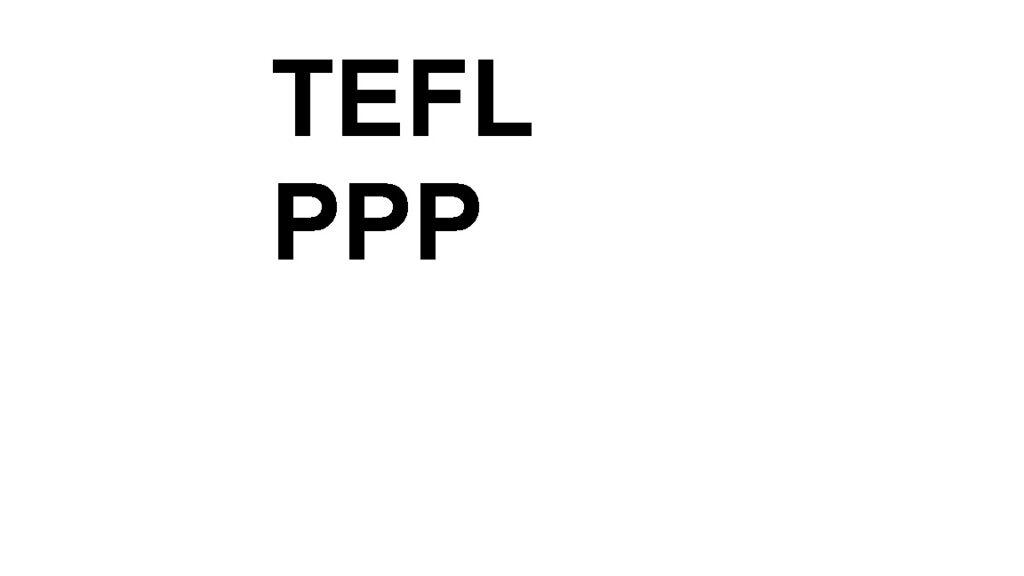TEFL PPP
What are the PPP? its advantage and limitation, How you can use it in class, all of that and more we are going to discuss today.
First what is PPP?
PPP stands for Presentation, Practice, and Production, which is a widely used methodology in Teaching English as a Foreign Language (TEFL). It provides a structured framework for teaching language skills and grammar to non-native English speakers. The PPP approach follows a three-stage sequence:
Presentation:
In this stage, the teacher introduces new language items such as vocabulary, grammar rules, or functional language to the students.
The teacher may use various techniques, including visuals, realia, gestures, or explanations, to present the target language in a clear and comprehensible manner.
The focus is on providing students with a clear understanding of the language items and their meaning.
During the presentation stage, the teacher introduces the new language items in a structured and systematic way.
The teacher may use various techniques to present the language, such as visuals, real-life examples, concept checking questions, or context-rich situations.
The aim is to make the language items meaningful and comprehensible to the students, ensuring they understand the meaning, form, and usage of the language.
Practice:
Once the language has been presented, the practice stage aims to reinforce and consolidate students’ understanding of the new language items.
Students engage in controlled practice activities that focus on specific language features.
These activities typically involve structured exercises, drills, or controlled dialogues where students practice using the language in a controlled context.
The teacher monitors and provides feedback and support to ensure accuracy and understanding.
The practice stage focuses on providing students with opportunities to practice and reinforce their understanding of the language.
Controlled practice activities are used to provide a structured and controlled environment for students to practice the target language.
These activities often involve completing exercises, drills, or gap-fill activities that focus on specific language features, such as grammar structures, vocabulary usage, or pronunciation patterns.
The teacher monitors the students’ progress, provides guidance, and offers corrective feedback to ensure accuracy and understanding.
Production:
The production stage encourages students to use the language in a more authentic and meaningful way.
Students engage in communicative activities where they have the opportunity to apply the language they have learned.
These activities can include role-plays, discussions, debates, or creative tasks that encourage fluency and creativity.
The focus shifts from accuracy to fluency, and students are encouraged to express themselves using the target language.
The production stage aims to promote fluency and communicative competence by providing students with opportunities to use the language in a more authentic and meaningful way.
Students engage in communicative activities that encourage them to produce language independently and creatively.
These activities can include role-plays, information gaps, problem-solving tasks, debates, or discussions on various topics.
The focus shifts from accuracy to fluency, and students are encouraged to express themselves using the target language effectively.
The teacher acts as a facilitator, providing support, monitoring interactions, and offering feedback as needed.
Overall, the PPP methodology provides a structured approach to language teaching, allowing students to progress from understanding and controlled practice to more independent and meaningful language use. It emphasizes a balance between accuracy and fluency and provides a clear framework for teachers to guide their lessons effectively.
Please note that the above explanation is a general overview of the PPP methodology in TEFL. Different variations and adaptations of this methodology may exist depending on the specific teaching context, learner needs, and teacher preferences.
Advantages of PPP methodology:
Structured approach: PPP provides a clear and organized framework, making it easier for both teachers and students to follow the lesson progression.
Gradual learning: The presentation-practice-production sequence allows students to gradually build their knowledge and skills in a step-by-step manner.
Controlled practice: Controlled practice activities in the practice stage provide a safe and structured environment for students to practice the language accurately.
Communicative focus: The production stage promotes communicative competence by encouraging students to use the language in meaningful and authentic contexts.
Teacher guidance: The teacher plays a crucial role in providing explanations, feedback, and support throughout the different stages, ensuring students’ understanding and progress.
Limitations of PPP methodology:
Potential for overemphasis on accuracy: Due to the structured nature of PPP, there is a risk of focusing too much on accuracy, which may hinder students’ fluency development.
Limited creativity: The controlled practice activities may limit students’ opportunities for creative language use.
Lack of real-world complexity: While the production stage aims to promote authentic language use, the activities may not always reflect the complexity and unpredictability of real-world language situations.
It’s important to note that PPP is just one of many teaching methodologies, and its suitability may vary depending on factors such as learner needs, teaching context, and lesson objectives. Teachers often adapt and combine different approaches to create a balanced and effective learning experience for their students.
Certainly! The PPP methodology can be adapted and modified to suit different teaching contexts and learner needs. Here are a few examples of how PPP can be adjusted:
Beginner Level:
In the presentation stage, the teacher can use a lot of visuals, realia, and gestures to make the language items more accessible to beginners.
For practice activities, the teacher can provide simplified exercises with ample support and repetition to help students grasp the basic structures and vocabulary.
In the production stage, the focus can be on simple role-plays or pair work where students use the language in a controlled and guided manner.
Young Learners:
For presentation, the teacher can incorporate songs, chants, or stories to engage young learners and make the language more memorable.
Practice activities can involve games, puzzles, or interactive tasks that cater to the shorter attention span and active learning preferences of young learners.
In the production stage, the teacher can facilitate group activities like creating and performing skits, conducting surveys, or playing interactive language games.
Business English:
In the presentation stage, the teacher can introduce language items within the context of business scenarios, using authentic materials like business emails, reports, or presentations.
Practice activities can include role-plays of business meetings, negotiations, or presentations, where students practice using the language in realistic business contexts.
The production stage can involve group discussions or debates on business-related topics, case studies, or simulations of real-life business situations.
Exam Preparation:
In the presentation stage, the teacher can focus on teaching specific exam-related language and strategies, such as exam techniques, time management, or question analysis.
Practice activities can involve completing past exam questions, mock exams, or targeted exercises that mirror the format and requirements of the exam.
The production stage can include timed speaking activities, writing tasks, or group discussions where students apply their exam skills and demonstrate their language proficiency.
Multilevel Classes:
In the presentation stage, the teacher can provide differentiated instruction by adjusting the language complexity or providing additional explanations based on the students’ proficiency levels.
Practice activities can be designed with different levels of difficulty, allowing students to choose activities that match their abilities or providing additional support for lower-level learners.
The production stage can involve group work or collaborative tasks where students with different proficiency levels can support and learn from one another.
These are just a few examples of how the PPP methodology can be adapted to different teaching contexts. Teachers can be creative and flexible in modifying the stages, materials, and activities to meet the specific needs and goals of their students.
Ppp for exam prepration
tainly! Here are some more examples of how the PPP methodology can be adapted for exam preparation:
- Presentation:
- Focus on familiarizing students with the exam format, instructions, and question types they will encounter in the exam.
- Provide clear explanations and examples of specific exam-related language and strategies, such as effective note-taking, skimming and scanning, or paraphrasing techniques.
- Use sample texts, audio recordings, or visuals similar to those found in the exam to present and analyze language features and test-taking strategies.
- Practice:
- Create practice exercises that closely resemble the exam tasks, ensuring students are familiar with the format and requirements.
- Start with controlled practice activities that focus on specific language or skills needed for the exam, such as grammar exercises, vocabulary matching, or sentence completion.
- Gradually increase the level of difficulty and complexity in the practice activities to simulate the exam conditions and challenge students’ abilities.
- Production:
- Provide opportunities for students to apply their exam skills in more authentic and open-ended tasks.
- Conduct timed speaking practice sessions where students respond to exam-style prompts or engage in simulated conversations and role-plays.
- Assign writing tasks that mirror the exam requirements, such as writing essays, summaries, or formal letters, and provide feedback on content, organization, and language use.
- Encourage peer feedback and self-assessment to promote reflection and improvement.
- Mock Exams:
- Administer full-length mock exams to familiarize students with the timing, pacing, and overall experience of the actual exam.
- Analyze the mock exam results to identify areas of strength and weakness for each student and provide targeted feedback and additional practice in those areas.
- Use the mock exams as a diagnostic tool to assess students’ progress and adjust teaching strategies accordingly.
- Exam Strategies:
- Dedicate specific sessions to teach test-taking strategies and techniques, such as time management, skimming and scanning, process of elimination, and educated guessing.
- Practice strategies through guided exercises and discussions, allowing students to apply them to different exam tasks.
- Provide tips and advice on managing test anxiety, building confidence, and maintaining focus during the exam.
Remember, when adapting PPP for exam preparation, it’s important to strike a balance between teaching exam-specific skills and ensuring overall language development. The goal is to equip students with the necessary language proficiency and exam strategies to perform well in the exam while maintaining a broader focus on improving their English language abilities.
Find us on Facebook
Practice Digital SAT

